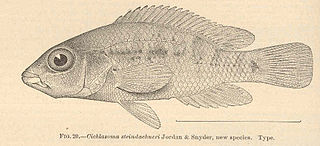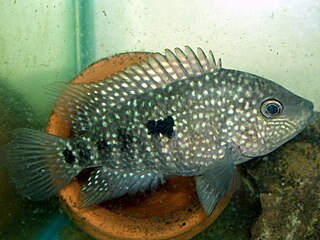
Cichlids are fish from the family Cichlidae in the order Cichliformes. Traditionally Cichlids were classed in a suborder, the Labroidei, along with the wrasses (Labridae), in the order Perciformes, but molecular studies have contradicted this grouping. On the basis of fossil evidence, it first appeared in Tanzania during the Eocene epoch, about 46–45 million years ago; however, molecular clock estimates have placed the family's origin as far back as 67 million years ago, during the late Cretaceous period. The closest living relative of cichlids is probably the convict blenny, and both families are classified in the 5th edition of Fishes of the World as the two families in the Cichliformes, part of the subseries Ovalentaria. This family is large, diverse, and widely dispersed. At least 1,650 species have been scientifically described, making it one of the largest vertebrate families. New species are discovered annually, and many species remain undescribed. The actual number of species is therefore unknown, with estimates varying between 2,000 and 3,000.

The Pánuco River, also known as the Río de Canoas, is a river in Mexico fed by several tributaries including the Moctezuma River and emptying into the Gulf of Mexico. The river is approximately 510 kilometres (320 mi) long and passes through or borders the states of Mexico, Hidalgo, Querétaro, San Luis Potosí, Tamaulipas, and Veracruz. According to the Atlas of Mexico, it is the fourth-largest river in Mexico by volume of runoff, and forms the sixth-largest river basin in Mexico by area.

Geophagus is a genus of cichlids that mainly live in South America as far south as Argentina and Uruguay, but a single species, G. crassilabris is from Panama. They are found in a wide range of freshwater habitats. They are part of a group popularly known as eartheaters and mostly feed by picking up mouthfuls of sediment to sift out food items such as invertebrates, plant material and detritus. The largest species reach up to 28 cm (11 in) in standard length. They are mostly kept in aquariums.

Fundulidae is the family of topminnows and North American killifishes.

Astronotus is a genus of South American fish from the family Cichlidae. There are two commonly recognized species in the genus, though genetic evidence suggests that additional species exist; several of these possibly distinct populations also have very different juvenile coloration from the two recognized species. Both of the commonly recognized species are found in the Amazon Basin, while one of two also is found in the Paraná and Paraguay rivers. Astronotus species grow to 35 cm in size, and are monomorphic. They are opportunistic omnivores and consume a range of smaller fish, fruits, nuts, crustaceans, mollusks and other invertebrates in the wild.

Herichthys is a small genus of cichlid fishes. Most are endemic to Mexico, but H. cyanoguttatus is also found in southern Texas, and has been introduced to central Texas and Florida. In 2015, the genus was split, and 7 species moved into Nosferatu.
Barton's cichlid is a species of cichlid endemic to freshwater springs in the upper Panuco River basin of San Luis Potosí, Mexico.

The Cichlasomatinae are a subfamily of cichlid fishes, including all cichlids native to the Greater Antilles, United States, Mexico and Central America, and many of the cichlids from South America. The subfamily Cichlasomatinae is often divided into two tribes: Cichlasomatini and Heroini, however some authorities classify these two tribes as part of the wider Neotropical and marginally Nearctic subfamily Cichlinae.

Heroini is a fish tribe from the Cichlasomatinae subfamily in the cichlid family. All cichlids native to the Greater Antilles, United States, Mexico and northern Central America are members of this tribe. It also includes most cichlid species in southern Central America and several species from South America. A large percentage of its species were formerly placed in the genus Cichlasoma but have since been moved to other genera.

The Julimes pupfish is a species of killifish in the family Cyprinodontidae. This pupfish is endemic to El Pandeño, a hot spring in Julimes, Chihuahua, Mexico, and it is adapted to life in water that reaches temperatures as high as 46 °C (114 °F). Consequently, it has been referred to as the "hottest fish in the world", although the closely related Cyprinodon pachycephalus can occur in somewhat warmer waters. Cyprinodon julimes was scientifically described in 2009 as similar to Cyprinodon eximius, but it has a bigger head, nearly one-third of its standard length.
Nosferatu labridens, the curve-bar cichlid, is a species of cichlid freshwater fish endemic to the Laguna Media Luna and headwaters of the Río Verde between 1,000–1,100 m (3,300–3,600 ft) above sea level in the state of San Luis Potosí, Mexico. Its range is a part of the upper Panuco River basin. It shares its distribution with the related Nosferatu bartoni. Nosferatu labridens can reach a maximum total length of 25 cm (10 in). It is endangered due to habitat loss, pollution and introduced species.
Nosferatu pantostictus, the Chairel cichlid, is a species of cichlid native to the Panuco River drainage of Mexico's Atlantic coast where it is mostly found in moderately fast flowing rivers, slightly brackish, murky lakes and lagoons along the coast. It reaches a maximum size of 12.6 centimetres (5.0 in) SL though most do not exceed 5.6 centimetres (2.2 in) TL. This species can also be found in the aquarium trade.

Nosferatu steindachneri, Steindachner's cichlid, is a species of cichlid endemic to Mexico where it is found in the Tamasopo, Gallinas and Ojo Frio Rivers of the Panuco River basin. It reaches a maximum size of 40.0 centimetres (15.7 in) SL. This species can also be found in the aquarium trade. The specific name honours the Austrian ichthyologist Franz Steindachner (1834-1919).

Nosferatu molango, also known as Atezca Cichlid, is a species of cichlid endemic to the "Laguna Atezca", in the headwaters of the Rio Moctezuma, in the municipality of Molango, state of Hidalgo, Mexico at 1,270 meters above sea level. It is distinguished from other species of the genus in "having a slender, well-spaced, unicuspid and conical, posterior slightly flattened, indented lower pharyngeal plate, with 2 rows of 8–9 medium-sized, lightly pigmented molars that flank the midline; 11–13 nonenlarged conic teeth along the posterior margin. Distinguished from all other species in the genus by a combination of the following characters: predorsal contour deep and nonacute, which is not concave before the eye; head short, rostral tip to the pectoral fin origin distance ; caudal peduncle short and deep, long anal fin ; wide preorbit ; eye small. Peritoneum is uniformly very dark."

Nosferatu pratinus, also known as green labridens or mojarra caracolera verde in Spanish, is a species of cichlid "endemic to the Rio el Salto,in the Rio Pánuco Basin in Mexico. The river runs through the Sierra La Colmena, where a series of pools and cascades called “Micos” occur. The area includes seven cascades with heights of five meters or more. Up the river is a town called El Naranjo, which is 102 km north from Ciudad Valles at the border between the States of Tamaulipas and San Luis Potosí. Two kilometers upstream from El Naranjo exists a series of pools and cascades, such as El Salto and El Meco, which are 70-m and 35-m high, respectively; both sites are inhabited by H. pratinus."

Nosferatu pame, previously placed in the genus Herichthys, also known as labridens 'white' or mojarra caracolera blanca in Spanish, is a species of cichlid "endemic to the main stem and tributaries of the Rio Gallinas, including Rio Tamasopo, Ojo Frío, and Agua Buena, upriver from the Tamul cascade" in the Pánuco River Basin, San Luis Potosí, Mexico.

Herichthys tepehua is a species of cichlid endemic to Mexico where it occurs in the Pantepec, Cazones, Tenixtepec, Tecolutla and Solteros River drainages in the states of Veracruz and Puebla. The specific name alludes to the Tepehua ethnic group and language, these people live in eastern México, in the states of Veracruz and Puebla, in the region where this cichlid is found.

Herichthys teporatus, also known as the Soto la Marina cichlid, is a species of cichlid fish endemic to Mexico where it occurs in the Soto La Marina River drainage in the state of Tamaulipas.

Mauricio de la Maza-Benignos is a Mexican conservationist, naturalist, zoologist and multi award winning filmmaker. He is also a member of Mexico's National System of Researchers. In addition to his work in ichthyology, he is an agronomist and zootechnician, a jurist, an administrator, and an editor.
The Cichlid Room Companion (CRC) is a membership-based webpage dedicated to the fishes of the Cichlid family (Cichlidae). The site was launched in May 1996 and offers arguably the most comprehensive authoritative catalogue of cichlids on the web, which is illustrated with more than 25,000 photographs of fishes and 2,000 of habitats, as well as over 300 videos of cichlids and their habitats. It also “offers access to ample information about 253 genera and 2371 species”, a discussion forum as well as many articles about taxonomy, natural history, fish-keeping, field accounts, conservation, and other cichlid related topics; mostly written by citizen scientists and people who specialize in cichlids. The species summaries provided in the form of profiles include taxonomic, distribution and habitat, distribution maps, conservation, natural history, captive maintenance, images, videos, collection records, and an extensive bibliography of the species included and have been prepared by world-class specialists. A document establishes the standards followed in the preparation and maintenance of the cichlid catalogue. The site is administered by its creator and editor, Juan Miguel Artigas-Azas, a naturalist, who is also an aquarist and a nature photographer. In 2008, the American Cichlid Association (ACA) awarded Artigas-Azas the Guy Jordan Retrospective Award, which is the maximum honor that association gives to people who have done extensive contribution to the international cichlid hobby.
















